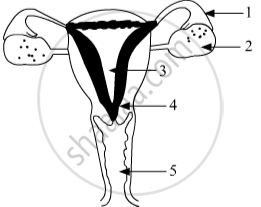Advertisements
Advertisements
Question
When a female child is born, her ovaries already contain thousands of immature eggs (or ova) contained in immature structures A. On maturing, A bursts open and an egg shoots out of the ovary in a process called B. The process B starts in the females at puberty and occurs again and again after a time period x. Before every occurrence of process B, the inner lining of uterus becomes thick and soft with lots of blood vessels in it. When the egg cell gets fertilised by a sperm, then an event C occurs in the life of mature human female which lasts for time period y leading to the birth of baby. If, however, the egg cell released by the ovary does not get a sperm to fuse with, then the thick and soft inner lining of uterus breaks down and comes out of the female's body in an event called D. The occurrence of event D is controlled by chemical substances E.
(a) What are A?
(b) What is process B?
(c) What is the time period x?
(d) Name the event C.
(e) How much is the time period y?
(f) What is the name of process D?
(g) Name the chemical substances E.
Solution
(a) A represents immature follicles.
(b) B represents the process of ovulation.
(c) The time period x is 28 days.
(d) The event C is pregnancy.
(e) The time period y is the gestation period, i.e., 9 months.
(f) D represents the process of menstruation.
(g) The chemical substance E is the hormone oestrogen.
APPEARS IN
RELATED QUESTIONS
List two functions ovary of human female reproductive system.
State the main function of the Leydig cells
The diagram given below is that of a developing human foetus. Study the diagram and then answer the questions that follow:

(i) Label the parts numbered 1 to 3 in the diagram.
(ii) Mention any two functions of the part labelled 2 in the diagram.
(iii) Explain the significance of the part numbered 3 in the diagram.
(iv) Define the term ‘Gestation’. What is the normal gestational period of the developing human embryo?
(v) Mention the sex chromosomes in a male and female embryo.
What are the male and female gonads in human beings? Mention their functions.
Name the following:
Male and Female organs on specific individuals.
Identify the given diagram.
Name the parts 1 to 5. 
Differentiate
Urinogenital system and Urinary system.
Explain the term Parturition or birth.
Choose the Odd One Out:
Choose the Odd One Out:
